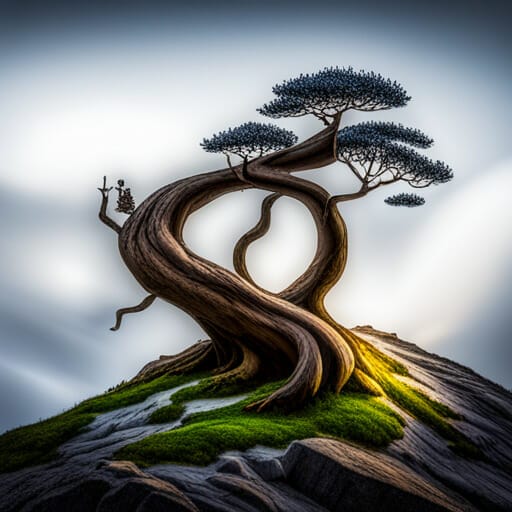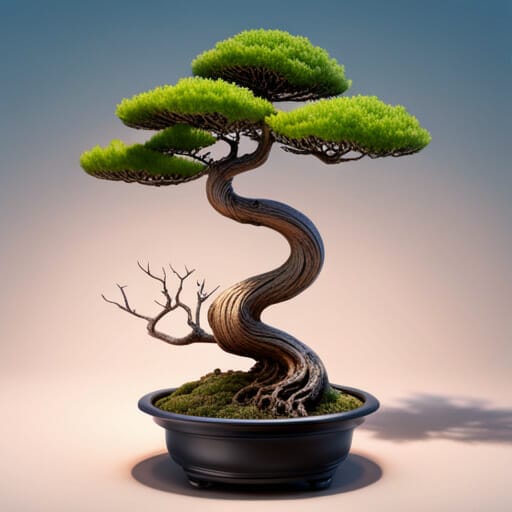Have you ever wondered how nature’s beauty can be captured and enhanced through the art of bonsai?
One particular technique, known as tanuki bonsai, seeks to create a striking contrast between living and deadwood, resulting in a captivating display of contrasting beauty.
In this article, we will explore the art of tanuki bonsai and delve into its techniques, process, controversy, and value.
Tanuki bonsai involves the artificial creation of the appearance of age, combining a young tree with a larger, dead tree to emulate the natural growth process that takes hundreds of years.
Through meticulous techniques, the smaller whips are planted in grooves of the dead tree, merging together as they grow to create the illusion of a single, older tree.
However, this practice has sparked controversy, as some individuals may pass off these man-made creations as naturally aged bonsai, potentially deceiving buyers.
While the quality of tanuki bonsai relies on the skill and effort invested in its creation, close examination may reveal an unnatural appearance.
Consequently, the value of tanuki bonsai is often less than that of naturally older bonsai trees.
As aspiring bonsai enthusiasts, it is essential to approach the art of tanuki bonsai with caution and awareness, ensuring transparency from sellers.
Ultimately, the joy and satisfaction derived from this art form lie in personal preference and the pursuit of beauty that serves and enriches our lives.
Contents
- 1 Quick Points
- 2 What is it?
- 3 Techniques and Process
- 4 Controversy and Value
- 5 Frequently Asked Questions
- 5.1 How long does it typically take for a tanuki bonsai to be created?
- 5.2 Can any type of tree be used for creating a tanuki bonsai?
- 5.3 Are tanuki bonsai considered to be less valuable than naturally older bonsai trees?
- 5.4 Are there any risks or drawbacks to creating a tanuki bonsai?
- 5.5 Is it possible to tell if a bonsai tree is a tanuki bonsai or a naturally older tree just by looking at it?
Quick Points
- Tanuki bonsai are artificially created to look older than they are.
- They involve combining a small, young tree with a larger, dead tree.
- Tanuki bonsai are controversial and seen as dishonest shortcuts.
– Tanuki bonsai are usually not worth much compared to naturally older bonsai trees.
What is it?

The art of tanuki bonsai involves artificially creating the appearance of an older tree by combining a small, young tree with a larger, dead tree, resulting in a contrast between living and deadwood similar to natural bonsai trees.
This technique is employed to expedite the development process, as natural tanuki bonsai can take hundreds of years to form. Man-made methods are used to speed up the process by adding grooves to the dead tree and planting smaller whips in them. Over time, the two trees merge together, giving the illusion of a single, ancient tree.
However, tanuki bonsai are controversial within the bonsai community, as they are seen as dishonest shortcuts. Some individuals may attempt to pass off tanuki bonsai as naturally older trees to increase their value. While the quality of tanuki bonsai depends on the craftsmanship, they can appear unnatural upon closer inspection. Additionally, tanuki bonsai usually do not hold the same value as naturally older bonsai trees.
Therefore, caution is advised when considering the purchase or creation of a tanuki bonsai.
Techniques and Process

One commonly used technique in the process of creating a tanuki bonsai involves merging a small, young tree with a larger, dead tree, resulting in the appearance of a single, harmonious entity.
This technique requires careful craftsmanship and attention to detail. To achieve the desired effect, the following steps are typically followed:
- Selecting a suitable small, young tree and a larger, dead tree with interesting and complementary shapes.
- Creating grooves in the dead tree to accommodate the branches of the small tree.
- Securing the small tree’s branches into the grooves and ensuring a stable connection.
- Allowing the trees to grow together over time, ensuring proper care and maintenance.
By following these techniques, bonsai enthusiasts can create tanuki bonsai that exhibit the contrast between living and deadwood, mimicking the appearance of naturally aged bonsai trees.
It is important to note that this technique should be approached with caution and transparency to maintain the integrity of the art form and serve the interests of others.
Learn The Benefits And Considerations Of Tanuki Technique
Controversy and Value

Controversy surrounds the practice of artificially merging a small, young tree with a larger, dead tree in the bonsai community due to concerns about the authenticity and transparency of the resulting tanuki bonsai.
Some bonsai enthusiasts argue that tanuki bonsai are dishonest shortcuts that deceive buyers by presenting a falsely aged tree. This lack of transparency raises ethical questions about the practice.
Additionally, the quality of tanuki bonsai can be questionable, as they may appear unnatural up close. In some cases, unscrupulous sellers may pass off tanuki bonsai as naturally older trees in order to increase their value.
As a result, tanuki bonsai are generally not worth as much as naturally aged bonsai trees. While personal preference plays a role in choosing to acquire a tanuki bonsai, caution is advised to ensure transparency and ethical considerations are taken into account.
Explore Juniper Bonsai Shapes And Styles
Frequently Asked Questions
How long does it typically take for a tanuki bonsai to be created?
The creation of a tanuki bonsai, an artificial tree made to appear older than it is, involves combining a small, young tree with a larger, dead tree. This process can take hundreds of years to occur naturally, but man-made techniques are used to speed up the process.
Can any type of tree be used for creating a tanuki bonsai?
Yes, any type of tree can be used for creating a tanuki bonsai. However, juniper and pine are the most common species used due to their compatibility with deadwood. Deciduous trees are less likely to be used.
Are tanuki bonsai considered to be less valuable than naturally older bonsai trees?
Tanuki bonsai are generally considered to be less valuable than naturally older bonsai trees. Due to their artificial nature, tanuki bonsai lack the authenticity and natural growth that is highly prized in the bonsai community.
Are there any risks or drawbacks to creating a tanuki bonsai?
Creating a tanuki bonsai poses several risks and drawbacks. It is considered controversial and dishonest, as some may pass it off as an older tree. Up close, they can appear unnatural and lack the value of naturally older bonsai trees.
Is it possible to tell if a bonsai tree is a tanuki bonsai or a naturally older tree just by looking at it?
It is generally difficult to determine if a bonsai tree is a tanuki bonsai or a naturally older tree just by visual inspection. However, up close, tanuki bonsai may appear unnatural due to the merging of the live and dead wood.




